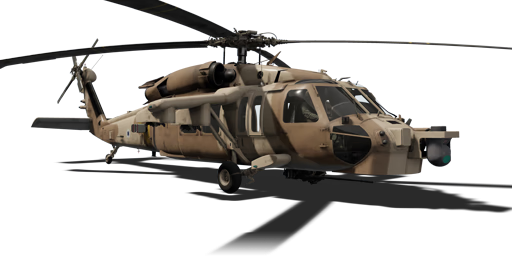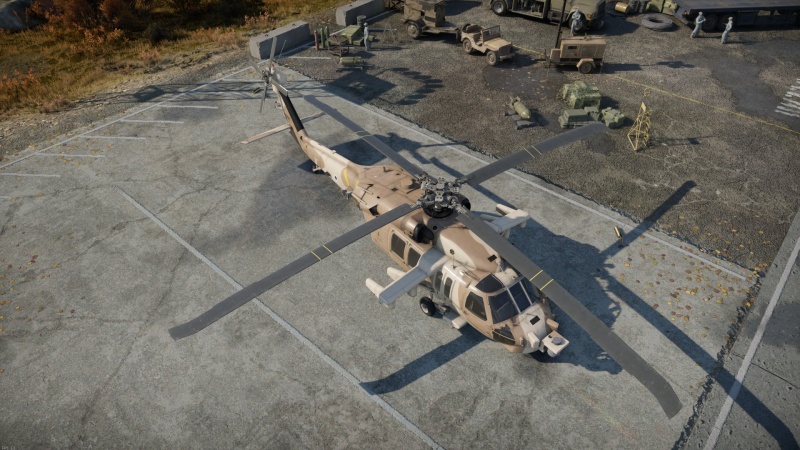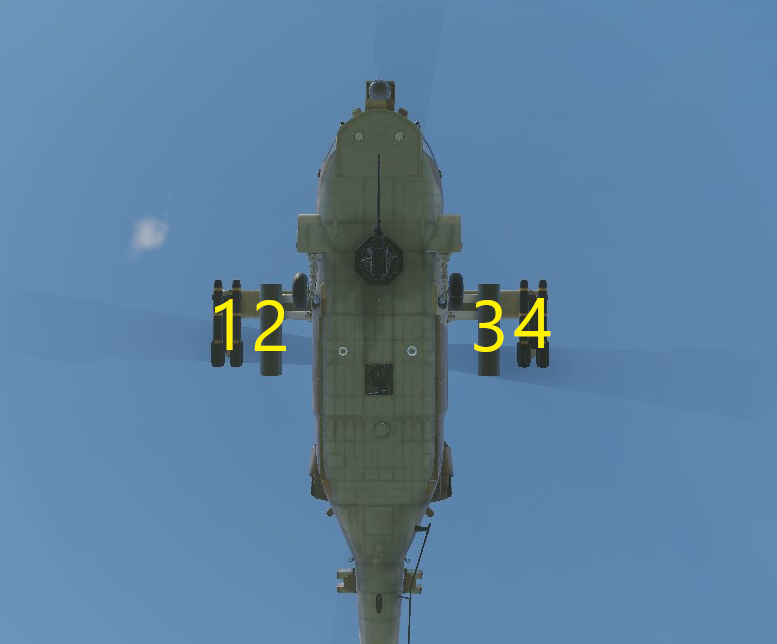Difference between revisions of "AH-60 (Israel)"
Colok76286 (talk | contribs) (Edits) |
Colok76286 (talk | contribs) (→Media: Edits) |
||
| (4 intermediate revisions by 3 users not shown) | |||
| Line 162: | Line 162: | ||
== Media == | == Media == | ||
<!-- ''Excellent additions to the article would be video guides, screenshots from the game, and photos.'' --> | <!-- ''Excellent additions to the article would be video guides, screenshots from the game, and photos.'' --> | ||
| − | '' | + | ;Videos |
| + | {{Youtube-gallery|jkmOIUyJmZE|'''The Most Broken Helicopter - AH-60 Battlehawk Ultimate Review''' - ''Bob Dickinson''|3aW9l_3LlG4|'''The Shooting Range #401''' - ''Metal Beasts'' section at 00:24 discusses the {{PAGENAME}}.}} | ||
== See also == | == See also == | ||
Latest revision as of 09:51, 27 October 2024
Contents
Description
Dating back to tests in the 1980s, the Israeli Air Force had been very interested in an alternative to their Bell-212 "Anafa" (Hebrew: Heron), thus beginning their long history with the UH-60 "Black Hawk". With about 50 in service as utility aircraft for logistics duties, it was a landmark in the IAF helicopter fleet. In recent years, the demand for more options to meet surface threats increased and thus the decision was made to buy armed versions of the platform. This model represents the upgraded UH-60L co-manufactured by Elbit Systems for the Colombian army with the designation AH-60L Arpía IV and showcased in 2008 as the "Armed Blackhawk Demonstrator", also nicknamed "Battle Hawk".
Introduced in Update "Alpha Strike", the AH-60 marks a new helicopter chassis available to the Israeli tech tree in form of the iconic Sikorsky "Black Hawk". With this new platform, new options open up for anyone choosing to tread down this part of the tech tree. Access to up to 16 of the Spike F&F ATGM in conjunction with the AGM-114K Hellfire 2 in mixed loadouts is the main appeal of this helicopter. Additionally it features a higher rate-of-fire underslung GIAT M621 cannon than its counterparts at the battle rating. The AH-60 "Yanshuf" (Hebrew: Owl) marks a viable alternative to its AH-64 competitors and a step-up in every regard to the MD-500 "Lahatut" preceding it in the tech tree.
General info
Flight performance
In its fully spaded configuration the AH-60 features a marginally worse climb rate than the AH-64D "Saraph" of ~10m/s in a straight climb. It features a sustained top speed of ~250 m/s (0 m/s climb) in realistic settings. The sustained yaw is quite poor, but expected for a platform of this size. Pitch and roll rate are quite decent and make this helicopter feel decently mobile in conjunction with its decent climb and speed.
| Characteristics | Max speed (km/h at _,___ m) |
Max altitude (metres) | |
|---|---|---|---|
| AB | RB | ||
| Stock | ___ | ___ | 5700 |
| Upgraded | ___ | ___ | |
Survivability and armour
The AH-60 does not feature any cockpit armour or armoured glass. The fuel tanks are quite large and placed in the rear of the vehicle. This tends to make them prone to getting hit and causing fuel fires in front and rear aspect shots. The vehicle itself features lots of empty space, which can be a blessing and a curse as its large signature makes it quite visible.
Your main survivability stems from your highly advanced defence systems such as the fully digital RWR covering all radar bands. The AH-60 comes equipped with 120 regular calibre countermeasures. Additionally it gets access to a (researchable) MAW - missile approach warning - and a laser warning receiver.
Modifications and economy
Armaments
| Ballistic Computer | ||
|---|---|---|
| CCIP (Guns) | CCIP (Rockets) | CCIP (Bombs) |
| |
|
|
Offensive armament
The AH-60 (Israel) is armed with:
- A choice between two presets:
- 1 x 20 mm GIAT M.621 cannon (430 rpg) + 120 x countermeasures
- 1 x 20 mm GIAT M.621 cannon + 120 x countermeasures + IRCM
Suspended armament
The AH-60 (Israel) can be outfitted with the following ordnance:
| 1 | 2 | 3 | 4 | ||
|---|---|---|---|---|---|
| Hydra-70 M247 rockets | 19 | 19 | 19 | 19 | |
| AGM-114K Hellfire II missiles | 2, 4 | 2, 4 | 2, 4 | 2, 4 | |
| ATAS (AIM-92) missiles | 2 | 2 | 2 | 2 | |
| GATR missiles | 7 | 7 | 7 | 7 | |
| Spike ER missiles | 2, 4 | 2, 4 | 2, 4 | 2, 4 |
| Default weapon presets | |
|---|---|
| |
The AH-60 brings several options to the table. The stock loadout consists of four AGM-114K Hellfire, which come in the usual 2 modification upgrades to eventually field four quad pylons of them for a total of 16. Following that, it gets access to Spike ER in double and quad setups, which can be mixed and matched with any other weapon options.
The AGM-114K Hellfire 2 is the usual weapon of choice for many American derivative systems. They loft post-launch to hit the target lit up by the laser indicator from a slight angle. They feature the highest explosive mass and penetration of helicopter ATGMs. Due to the nature of following the laser indicator, the missile does perform somewhat sluggishly and can fall short or fail to track a target moving at high speeds from side aspects. The laser can also get obstructed more easily by foliage. It is advisable to lock on to a target using the helicopter's IRST to achieve more consistent target tracking.
The Spike ER NLOS missile may be a new system for many players. It is functionally similar to its ground launched counterparts. However, it features a massively improved motor burning for much longer and therefore staying agile for more time. After designating a target, an NLOS missile automatically tracks a target post-launch. This comes with the advantage of being able to launch from behind a ridge and going back into hiding. The major drawback of this is that you cannot aim for enemy weak spots like ammo stowage or crew compartment. It is very possible the Spike will decide going for tracks or fuel tank, as such launching more than one missile at a time is advisable. NLOS missiles are also quite adept at tracking helicopters.
The GATR (Guided Advanced Tactical Rocket) may be familiar to players who have played the American helicopter tree. It is functionally identical to the laser guided semi-armour piercing APKWS II (M282), available to the AH-6 and OH-58D as well as the MH-60L DAP and AH-64 family. It does however have enhanced range compared to its peer. While it is a quite adept missile for attacking light targets like APCs, reconnaissance vehicles and SPAA, it finds itself outmatched with the majority of vehicles at this BR-range and should be traded in favour of the Spike ER.
The AIM-92A ATAS (Air-to-air Stinger) is a 13G overload missile to defend against air threats. Compared to analogues it is quite weak on the turn and can be defeated by simple manoeuvring if the target is attentive. Ideally, it is fired from a front or rear aspect or long distance side aspect, to give the missile time to manoeuvre into the enemy flight path. Trading a single weapon pylon for a pair of these can prove valuable as a defensive option in conjunction with your bottom-mounted cannon.
Lastly, the Hydra-70 M247 is the familiar unguided rocket, which helicopter players will be familiar with all the way since the Israeli reserve helicopter. Its 290 mm of penetration is lacking at this BR and the subpar protection of the helicopter against small calibre firearms may discourage such a playstyle.
Usage in battles
The AH-60 puts an emphasis on ground attack. Whilst this holds true for most helicopters, its ways of defending against aircraft are fairly limited. Equipping a double pylon of ATAS will require trading it out for one of the quad pylons of air-to-ground weaponry. The 20mm GIAT M621 can be competent at defending against aircraft due to its higher rate of fire and velocity than the AH-64s M230.
Running a mixed loadout of Spike ER and AGM-114K Hellfire II is recommended, as depending on the vehicle, the Spikes make for a poor experience. They tend to not overpressure, but make for an excellent distraction to flood the radar of an SPAA with. Against tanks, they tend to hit critical modules, but usually fail to destroy the vehicle in a single launch. As such the Hellfire as a secondary armament can prove a lethal option on the "wounded" prey, which when it hits it also tends to destroy the target.
The AH-60 serves best when emphasizing the usual helicopter playstyle of playing around defensive terrain, popping up to either scout or firing off ordnance. The decent climb rate of the platform is in support of that. This playstyle can be made more lethal by prioritising F&F weaponry to pop-up a few seconds later to get the kill with AGM-114 or staying hidden and waiting for hit confirmation. Spike ER can also be a strong anti-helicopter platform in its own right, as the quite slow, lofting missile tends to set off RWR at a much later, difficult to react, point in time.
For first-spawn missile runs, the platform serves as an option, but not a competitor to the AH-64 variants found on the other side of the helicopter tree. While it is able to load the same amount of air-to-ground ordnance, its poor frontal protection as well as its smaller calibre cannon make it an inferior choice. Additionally, its mobility is not quite as good as the other platform.
Pros and cons
Pros:
- Up to 16 x Spike ER ATGMs
- Mixed loadouts between Spike, Hellfires and complimentary weapons
- Excellent optics with modern third generation thermals and 63.5x magnification
- M621 bottom-mounted cannon, unusual for utility helicopter chassis
Cons:
- Both Spikes and Hellfires can be inconsistent at tracking/damaging targets
- No wingtip mounts for ATAS
- Massive silhouette
- No armour protecting the crew
- Limited trajectory on the bottom-mounted turret compared to designated attack helicopters
History
The Israeli military has a history with the UH-60 platform dating back to the 1970s. In 1971, the US Army had issued a contract to replace the UH-1 Iroquois for the development of a tactical medium assault and transport helicopter, with a greater emphasis on payload and survivability. The companies to respond to this were Sikorsky and Boeing, who built the YUH-60A and YUH-61A respectively. The US Army declared Sikorsky's design as the winner in 1976. It featured energy-absorbing landing gears, special instalments to prevent the rotors and engines from entering cargo and crew area, a reinforced fuselage for crash landings, as well as special fuel tank and feeding system to prevent the start of a fire. All this in conjunction with two new General Electric T700 engines, for a major upgrade in mobility, served to make this a worthy successor. Additionally, a multitude of navigational upgrades to aid the crew, make it a platform that serves a variety of international militaries to this day.
In 1983, the Israeli Air Force started their testing of the UH-60 platform, which similarly to the US Army, was intended to replace their fleet of UH-1 (Bell 212) helicopters. Initial impressions were positive, as the helicopter made it to Israel by direct flight with several mid-air refuelings along the way. After thorough testing, throughout the entire operational range of IAF missions and a variety of performance tests, the test crews were in favour of purchasing the UH-60. Almost a decade later, in 1994, Israel received its first shipment of ten Black Hawks, which received the Hebrew designation "Yanshuf" (Owl).
The UH-60 would soon see its first action in 1996, where in operation "Grapes of Wrath" it would fly in assault transport, logistics, rescue and evacuation missions. It also proved its capabilities in harsh weather. In the following years, the IAF decided to purchase more UH-60s and currently has 50 in service. Currently, there are another eight of its sister variant, the SH-60 "Sea Hawk", on order for anti-surface warfare capabilities near the Israeli coast. In 1999, the IAF modernised their Black Hawks to the "Yanshuf-2" standard, modifying the aircraft with in-flight refueling probes, modernised ECM, improved navigational equipment, night vision, and improved rescue systems.
As with many utility helicopter platforms, it was decide to enhance the lethality of the system beyond its logistics and personnel transport roles. In 2015, this task was entrusted to the Israeli company Elbit Systems, tasked with transforming the UH-60L into the AH-60L platform. Part of this expansive upgrade package were the inclusion of wing mounted pylons with compatibility to Rafael Spike LR and ER, as well as 70 mm guided and unguided rockets. Additionally, a 20 mm GIAT M621 cannon was mounted to the bottom of the helicopter. Besides increasing offensive capabilities, the vehicle also saw upgrades improve FLIR and EOP systems for target acquisition, integration of an improved HMD and replacing several analogue instruments with MFDs.
These upgrades culminated in the AH-60L Arpía IV (Spanish: "Harpy"), currently deployed by the Colombian Air Force, which also played a large role in determining specifications for the final aircraft design. The aircraft plays essential operational roles in countering guerrilla groups and enhancing the deterrent capabilities of the CAF. Additionally, it can serve in a wide of other mission types, such as anti-tank, logistics, transport and rescue. There are currently 12 AH-60L Arpía IV in service with the Colombian military. This platform also has entered testing with the Israeli Military in 2008, but funding has not yet been committed to the conversion of additional aircraft or a large scale implementation into the IAF.
Media
- Videos
See also
- Related development
External links
- https://old-forum.warthunder.com/index.php?/topic/554573-sikorsky-armedblackhawk-demonstrator/ Forum proposal and write-up on the Israeli "Armed Blackhawk Demonstrator"
- https://www.flightglobal.com/picture-israel-tests-armed-black-hawk-demonstrator/84297.article Israel testing armed Black Hawk demonstrator helicopter - Flightglobal.com
- https://web.archive.org/web/20170612235707/http://www.iaf.org.il/211-18318-en/IAF.aspx?indx=2 IAF.org article about the UH-60 Black Hawk (Yanshuf) platform
- https://web.archive.org/web/20090730164154/http://www.geocities.com/CapeCanaveral/Hangar/2848/yanshuf.htm Sikorsky UH-60 / S-70 Blackhawk (Yanshuf) history
| Sikorsky Aircraft Corporation | |
|---|---|
| Utility | H-34 |
| Attack | MH-60L DAP |
| Export | ▄H-34 · AH-60 |
| Israel helicopters | |
|---|---|
| Attack | |
| MD 500 | Lahatut |
| Battle Hawk | AH-60 |
| Cobra | Tzefa D/E · Tzefa A · Tzefa B |
| Apache | Saraph · Peten · AH-64A Peten |






